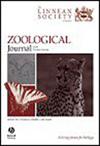抚仙湖古湖的多样性:8个淡水蜗牛新种的分类和系统发育研究(Triculinae: Pomatiopsidae
IF 2.8
2区 生物学
Q1 ZOOLOGY
引用次数: 0
摘要
抚仙湖是中国西南部云南省的一个古湖泊,拥有许多特有物种,但其生物多样性特征尚不明确。通过对其沿岸淡水蜗牛的全面调查,我们记录了三螺亚科中显著的生物多样性。本文描述了8个新种,包括4个Kunmingia属新种和4个代表一个新属的新种。Farshore He, Chen, Xiang和Zhang gen. 11 .线粒体部分基因(COI和16S核糖体DNA)和核标记(18S和28S核糖体DNA)的系统发育分析为支持这些新分类群的特异性提供了强有力的遗传证据。地方化淡水蜗牛的系统发育经时间校正后表明,在中新世晚期,抚仙湖的Kunmingia枝和Farshore枝发生分化,表明抚仙湖的地质历史可能比之前估计的要早。这些发现突出了抚仙湖作为淡水蜗牛多样性研究热点和研究古湖泊进化过程的独特系统的重要性。本文章由计算机程序翻译,如有差异,请以英文原文为准。
Diversity in an ancient lake: taxonomic and phylogenetic insights from eight new freshwater snail species (Triculinae: Pomatiopsidae) of Lake Fuxian, Southwest China
Lake Fuxian, an ancient lake in Yunnan Province, Southwest China, harbours many endemic species, yet its biodiversity remains poorly characterized. Through comprehensive surveys of freshwater snails along its shores, we documented remarkable biodiversity within the subfamily Triculinae. In this study, we describe eight new species, including four new species of the genus Kunmingia and four new species representing a new genus, Farshore He, Chen, Xiang and Zhang gen. nov. Phylogenetic analyses of partial mitochondrial genes (COI and 16S ribosomal DNA) and nuclear markers (18S and 28S ribosomal DNA) provided robust genetic evidence supporting the distinctiveness of these newly described taxa. The time-calibrated phylogeny of the endemic freshwater snails shows that Kunmingia clade and Farshore clade diverged in the late Miocene, suggesting that the geological history of Lake Fuxian might be older than previously estimated. These findings highlight the importance of Lake Fuxian as a hotspot of freshwater snail diversity and a unique system for studying evolutionary processes in ancient lakes.
求助全文
通过发布文献求助,成功后即可免费获取论文全文。
去求助
来源期刊
CiteScore
6.50
自引率
10.70%
发文量
116
审稿时长
6-12 weeks
期刊介绍:
The Zoological Journal of the Linnean Society publishes papers on systematic and evolutionary zoology and comparative, functional and other studies where relevant to these areas. Studies of extinct as well as living animals are included. Reviews are also published; these may be invited by the Editorial Board, but uninvited reviews may also be considered. The Zoological Journal also has a wide circulation amongst zoologists and although narrowly specialized papers are not excluded, potential authors should bear that readership in mind.

 求助内容:
求助内容: 应助结果提醒方式:
应助结果提醒方式:


